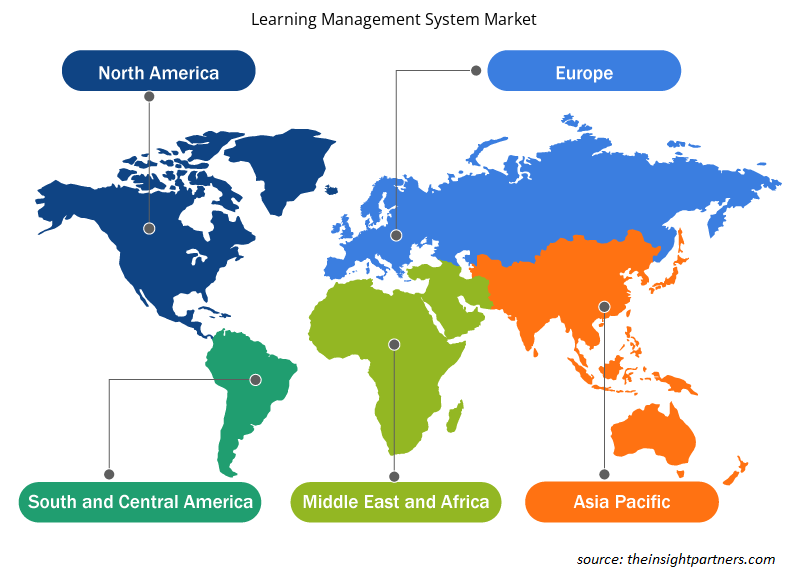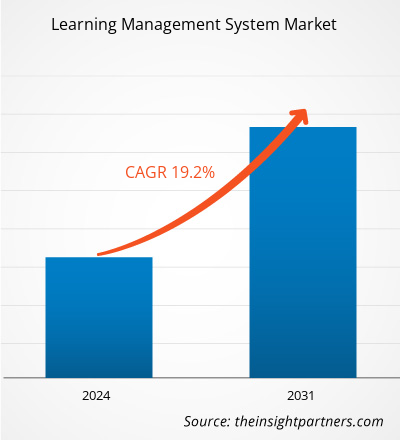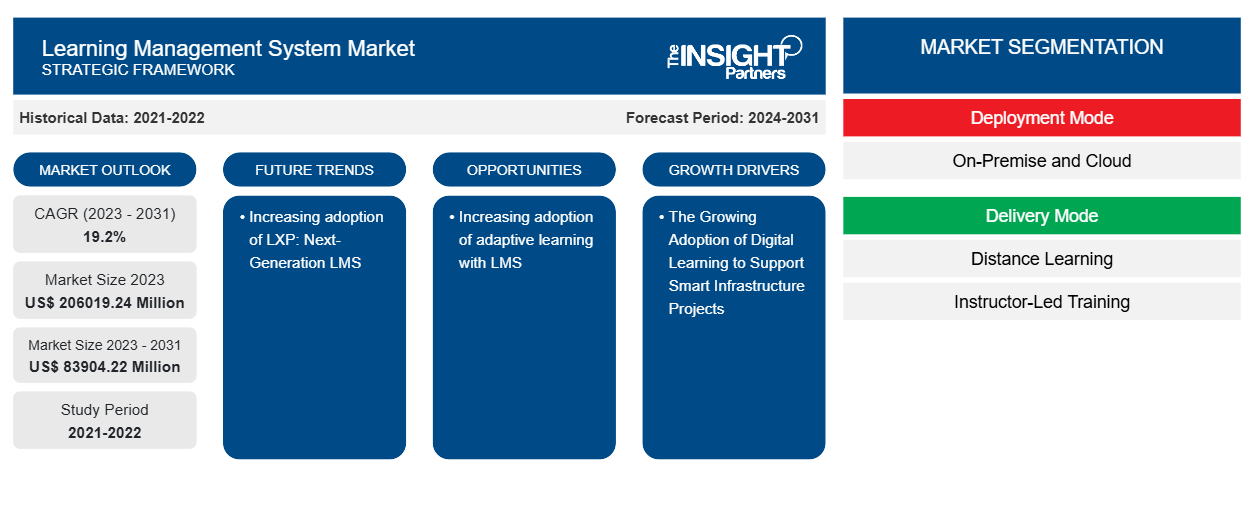学习管理系统市场规模预计将从 2023 年的 2060.1924 亿美元增至 2031 年的 839.0422 亿美元。预计 2023-2031 年期间市场复合年增长率将达到 19.2%。LXP:下一代 LMS 的采用率不断提高,很可能仍是市场的主要趋势。
学习管理系统市场分析
近年来,学习管理系统市场发展迅速,变化显著。由于学习管理系统平台能够高效地管理和提供教育内容,因此它如今已成为企业、教育机构和在线学习提供商的必备工具。远程学习和电子学习方法的普及度不断提高,导致市场需求显著增加。LMS 市场的增长源于许多与市场动态相关的变量。在线教育和远程学习计划的进步推动了对 LMS 平台的需求,而这些进步的推动力是对适应性强、可访问性强的学习解决方案的需求。此外,企业界已经意识到 LMS 平台对于员工培训和技能提升的重要性,这导致其在工作场所的使用率不断上升。
学习管理系统市场概览
各种规模的组织都可以在员工入职过程中使用学习管理系统作为强大的专业发展和培训软件工具。由于许多 LMS 平台都位于云端,因此可以进行远程访问。数据库管理与 LMS 中的数字架构相结合,以方便管理课程、时间表、培训材料、评估等。
定制此报告以满足您的需求
您可以免费定制任何报告,包括本报告的部分内容、国家级分析、Excel 数据包,以及为初创企业和大学提供优惠和折扣
-
获取此报告的关键市场趋势。这个免费样品将包括数据分析,从市场趋势到估计和预测。
学习管理系统市场驱动因素和机遇
数字化学习日益成为支持智能基础设施项目的一种方式
由于云服务的使用日益增多,云安全市场具有各种潜在前景。云服务的使用受到其优势的推动,这些优势包括可扩展性、灵活性和可负担性。但随着云服务越来越广泛地使用,包括数据泄露和网络攻击在内的安全风险也在增长。现在需要更好的安全解决方案来应对这些威胁。为了满足这一要求,预计云安全市场将迅速扩张。预计市场的增长将受到 SaaS 和 IaaS 类别的重大影响。这些解决方案的可扩展性、灵活性和成本效益是鼓励其使用的众多优势之一。
越来越多地采用 LMS 进行自适应学习
通过在 LMS 中使用自适应学习,学生将成为备考的主角和领导者。学生在访问电子学习网站后,将能够根据评估结果选择自己的学习路径。之后,LMS 平台可能会为每个学生提供专门针对其学习风格的信息,帮助他们确定和改进需要改进的领域,或解决任何模糊的问题或主题。为了让用户对平台和培训师都充满信心,这一策略至关重要。为了提高电子学习教育水平和对用户目标的投入,LMS 正在使用自适应学习。因此,LMS 越来越多地采用自适应学习,为市场创造了更多机会。
学习管理系统市场报告细分分析
有助于得出学习管理系统市场分析的关键部分是部署模式、交付模式和最终用户。
- 根据部署模式,学习管理系统市场分为本地和云。云部分在 2023 年占据了更大的市场份额。
- 根据交付模式,市场分为远程学习、教师指导培训和其他。
- 根据最终用户,市场分为 K-12、高等教育 和企业。
学习管理系统市场份额按地区分析
学习管理系统市场报告的地理范围主要分为五个地区:北美、亚太、欧洲、中东和非洲、南美和中美。
北美主导着学习管理系统市场。学习管理系统 (LMS) 市场在过去几年中增长迅猛,北美是这一扩张的主要贡献者。该地区领先的技术公司在基础设施和技术方面进行了大规模投资,从而开发出更复杂、更经济的 LMS 解决方案。北美市场的激烈竞争也促使人们创建更平易近人的学习管理系统 (LMS),该系统具有各种特性和功能,包括社交学习和游戏化。
学习管理系统市场区域洞察
Insight Partners 的分析师已详细解释了预测期内影响学习管理系统市场的区域趋势和因素。本节还讨论了北美、欧洲、亚太地区、中东和非洲以及南美和中美洲的学习管理系统市场细分和地理位置。

- 获取学习管理系统市场的区域特定数据
学习管理系统市场报告范围
| 报告属性 | 细节 |
|---|---|
| 2023 年的市场规模 | 20601924万美元 |
| 2031 年市场规模 | 83904.22 百万美元 |
| 全球复合年增长率(2023 - 2031) | 19.2% |
| 史料 | 2021-2022 |
| 预测期 | 2024-2031 |
| 涵盖的领域 |
按部署模式
|
| 覆盖地区和国家 |
北美
|
| 市场领导者和主要公司简介 |
|
学习管理系统市场参与者密度:了解其对业务动态的影响
学习管理系统市场正在快速增长,这得益于最终用户需求的不断增长,这些需求源于消费者偏好的不断变化、技术进步以及对产品优势的认识不断提高等因素。随着需求的增加,企业正在扩大其产品范围,进行创新以满足消费者的需求,并利用新兴趋势,从而进一步推动市场增长。
市场参与者密度是指在特定市场或行业内运营的企业或公司的分布情况。它表明相对于给定市场空间的规模或总市场价值,有多少竞争对手(市场参与者)存在于该市场空间中。
在学习管理系统市场运营的主要公司有:
- 黑板公司
- 基石
- D2L 公司
- 多塞博
- 国际商业机器公司
- 其学习
免责声明:上面列出的公司没有按照任何特定顺序排列。

- 获取学习管理系统市场顶级关键参与者概述
学习管理系统市场新闻和最新发展
学习管理系统市场通过收集主要和次要研究后的定性和定量数据进行评估,其中包括重要的公司出版物、协会数据和数据库。学习管理系统市场的一些发展如下所列:
- FSSC 宣布与移动学习平台 MobieTrain 建立新的合作关系,该平台将把培训转变为简短而有趣的体验。拥抱这一变化为我们打开了一个充满可能性的世界。凭借尖端的功能和用户友好的界面,该公司进入了一个学习变得比以往任何时候都更容易获得、更具吸引力和互动性的领域!观看这段 30 秒的视频,先睹为快。(来源:FSSC,新闻稿,2024 年 4 月。)
- 全球最大的免费在线赋能平台 Alison 宣布推出革命性的免费学习管理系统 (Free LMS)。该系统旨在让各种规模的组织(包括预算有限的组织)都能获得技能培训。(来源:三菱电机,新闻稿,2024 年 2 月)
学习管理系统市场报告覆盖范围和交付成果
“学习管理系统市场规模和预测(2021-2031)”报告对市场进行了详细分析,涵盖以下领域:
- 学习管理系统市场规模及全球、区域和国家层面所有主要细分市场的预测
- 学习管理系统市场趋势以及市场动态,如驱动因素、限制因素和关键机遇
- 详细的 PEST/波特五力分析和 SWOT 分析
- 学习管理系统市场分析涵盖主要市场趋势、全球和区域框架、主要参与者、法规和最新市场发展
- 行业格局和竞争分析,涵盖市场集中度、热图分析、知名参与者以及学习管理系统市场的最新发展
- 详细的公司简介
- 历史分析(2 年)、基准年、预测(7 年)及复合年增长率
- PEST和SWOT分析
- 市场规模、价值/数量 - 全球、区域、国家
- 行业和竞争格局
- Excel 数据集
近期报告
相关报告
客户评价
购买理由
- 明智的决策
- 了解市场动态
- 竞争分析
- 客户洞察
- 市场预测
- 风险规避
- 战略规划
- 投资论证
- 识别新兴市场
- 优化营销策略
- 提升运营效率
- 顺应监管趋势























 获取免费样品 - 学习管理系统市场
获取免费样品 - 学习管理系统市场